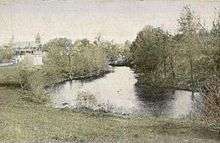Lamprey River
Coordinates: 43°03′54″N 70°54′18″W / 43.0651°N 70.9049°W

The Lamprey River is a 50.2-mile-long (80.8 km)[1] river in southeastern New Hampshire, the United States. It rises in Meadow Lake in Northwood, and flows south, then generally east past Raymond, Epping, Lee, Durham and finally Newmarket. Here, it meets Great Bay, a tidal inlet of the Atlantic Ocean, to which it is connected by a tidal estuary, the Piscataqua River. The river from the Bunker Pond Dam in Epping to the confluence with the Piscassic River is part of the designated National Wild and Scenic River System.
Wildlife
The shoreline of the Lamprey River, its floodplain and its wetlands provide a wide range of valuable wildlife habitats. Its anadromous fishery is one of the strongest in the Great Bay watershed. Anadromous fish species that use the Lamprey River include shad, river herring, smelt and even Atlantic salmon. These fish are hatched in the river, then spend most of their lives out at sea, returning to the river to spawn. The fish species will move up the river as far as Durham, where they are prevented from moving further upstream by Wiswall Dam.
The river is also rich in species of freshwater mussels. The river is managed by the New Hampshire Fish and Game Department for several different types of game fish, including brook trout which is native to the river. Rainbow trout and brown trout are also stocked in many parts of the river but are not native to the area.
The Lamprey River derives its name from the American Brook Lamprey, which is native to the river. The American Brook Lamprey is a type of freshwater jawless fish sometimes incorrectly referred to as the "Lamprey eel". The American Brook Lamprey is classified as an endangered species by New Hampshire Fish and Game but was once used as a valuable food source in the area. Lampreys were once eaten due to the fact that they contain no bones in their body other than in their head, which was ideal for small children.
History
Segments of the river are rich in history. Saw- and gristmills which operated by water power were common along the river. The Wiswall Falls Mills Site in Durham is on the National Register of Historic Places. Originally a sawmill, the site was used subsequently to make knives, nuts and bolts, pitchforks, carriages, matches and wallpaper. Sites such as Wadleigh Falls show the remnants of old mills and the rich river culture that used to be. Wadleigh Falls, located in Lee, is the remains of a dam created to power a mill which fed a 150-acre (61 ha) mill pond at one point.
Setting
Along the banks are hardwood forests and numerous farms. The area is under pressure from suburban development, however, as one of the fastest-growing areas in New England. There is a strong local culture surrounding the Lamprey River with several local events held on the river, including numerous town-run fishing derbies and the Lamprey River Canoe Race held annually in Epping.
During the course of its journey from the Saddleback Mountains in Northwood down to Newmarket, the Lamprey changes from a small torrential stream to a large tidal river. The river between these points has slow meanders and rapids, and small waterfalls such as Packers Falls in Durham.
See also
References
- http://www.lampreyriver.org/
- http://www.ci.epping.nh.us/ECC/
- http://www.wildlife.state.nh.us/Wildlife/Nongame/species_list.htm
- http://www.cowhampshireblog.com/2007/04/13/new-hampshire-glossary-lamprey-eel/
- http://www.lampreyriver.org/about-river-wildlife-fish
- http://des.nh.gov/organization/commissioner/pip/factsheets/rl/documents/rl-7.pdf